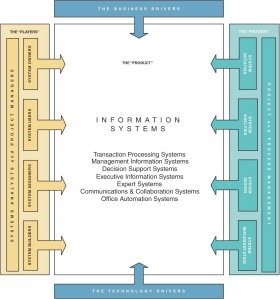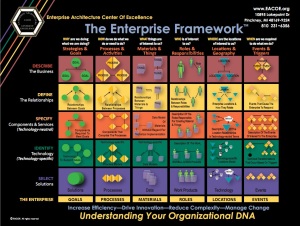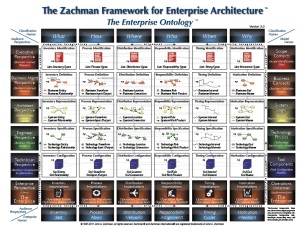INFORMATION DESIGN PERSPECTIVES: MIS 552 Group 4 Blog Report Assignment 1 September 07, 2011
Blog Report Assignment 1
“Information systems can be analyzed and designed from different perspectives. Discuss what perspectives are influencing the current practice of system analysis and design. Also, provide examples of system designed from various perspectives. Discuss at least three perspectives. For example, you can use “business intelligent” as one design perspectives. Do not use the three perspectives “Data, Process, Interface” as discussed in class.”
Information System Design Perspectives
Per Whitten, “the product of systems analysis and design is an information system”. He illustrates this concept with the following diagram that shows the context of systems analysis and design methods:
(Whitten & Bentley, 2005)
Note that there are four major influences on information systems analysis and design:
- Business Drivers
These include the underlying motivations of any and all organizations: the desires to improve Business Knowledge, Business Processes, and Business Communications
- “The Process”: Project and Process Management
These include the steps of the Software Development Life Cycle (SDLC): System Initiation, System Analysis, System Design, and System Implementation
- Technology Drivers
These include the underlying technical foundations of system design: Network Technologies, Database Technologies, Software Technologies, and Interface Technologies
- “The Players”: System Analysts and Project Managers
These include the people involved with any given information system which can range from customers to vendors, from business office staff to IT staff: System Owners, System Users, System Designers, and System Builders
(Whitten & Bentley, 2005)
The topic of design perspectives is much studied and debated subject matter. In his paper, “Different Perspectives in Designing Multi-Agent Systems”, Cossentino describes the multidimensional perspectives in a design process; this include the architectural, social, knowledge, resource, and computer perspectives. Zachman of the Enterprise Architecture Center of Excellence provides a framework similar to that of Whitten, but its focus is on the architecture of the enterprise as a whole rather than specifically on the design process. That said, it still provides food for thought on the complexities of designing from a multitude of perspectives. His framework includes the executive, business management, architect, engineer, technician, and enterprise perspectives.
(Cossentino; Zachman, 2011)
(EACOE, 2011)
(Zachman, 2011)
There are a myriad of perspectives that come into play when analyzing and designing information systems. Some examples include:
- Business drivers, such as globalization of the economy and electronic commerce
- Technology drivers, such as networks, the Internet, mobile and wireless technologies
- Stakeholders, such as system owners and system users
Each perspective is critical to the overall design of the system. The goal of system analysis and design is to take these perspectives into consideration and design a system that is compatible with each — without compromising system quality and performance. Whitten goes on to provide more detail to the framework in the diagram below by expanding on the information system building blocks:
(Whitten & Bentley, 2005)
Some specific perspectives and example systems are discussed below.
Business Drivers Perspective
A business is dependent on factors influencing the organization both internally and externally; these factors push a company to concentrate on improvement of knowledge, processes and communication. A successful entity must provide a combination systems, information, and people to work in a manner so as to avoid being overrun by competition. A balance has to be established between processes overcoming disadvantages in some and sacrificing some traditional methodologies in some to attain success. Better business drivers can be achieved by organizations by:
- Providing unique solutions or products or even services which can potentially attract customers. Such processes require more analysis and productive capacity.
- Providing services and products much faster with quality. This requires that the organization researches its complete process cycle and find potholes in it, then go about innovating them with an eye to increasing speed of every process to achieve faster business.
- Providing more environment-friendly products so that customers are benefited by the advantages such products provide.
Even new innovations brought about by technology constitute to business drivers. Software based on information technology help in overriding the disadvantages of errors caused by manual tasks; these include managing inventory, boosting sales, maintaining employee information, storing historical data for future analysis (Data warehousing), etc. Some of the most recognized names in any organization today include Customer Relationship Management System (CRM), Enterprise Resource Planning System (ERP), Human Resource Management System (HRM), etc. The availability of an abundant supply of open-source products and services (like Linux, an open-source OS which is provided free of cost) even act as a big business driver in the poor economy of today. The quality of such products and brand names associated with them (like Google’s Android OS) make customers lean towards such services and thus they act as a major business driver demanding uniqueness for a successful product.
Business drivers play an important role in the development of an information system. Some of these drivers become fads and lose their impact, while some continue to influence system development for many years. There are many current trends, including globalization of the economy, electronic commerce, collaboration and partnership, to name a few.
Globalization of the Economy is an important driver because of the implications it has to a business’s ability to compete effectively. Globalization provides both benefits in the form of new international markets for goods and services and challenges in the form of new international competition.
These factors influence an information system in the following ways:
• Information Systems and applications must be internationalized to
o Support multiple languages
o Support currency exchange rates
o Adhere to international trade regulations
o Adapt to different business cultures and practices
• Information must be consolidated internationally, beyond the limits of individual business locations and countries
• Communication must be possible on an international level
Electronic Commerce trends have opened up new opportunities for businesses to capitalize on by providing a business outlet that has the potential for availability 24 hours a day, 7 days a week. This requires:
• Effective use of the Internet for external transactions
• Ability to conduct day-to-day business within the organization using Internet technology
This has led to the development of information systems designed to run within the Internet using Internet browsers.
Collaboration and Partnership trends are having a tremendous influence on the design of Information systems. This influence extends the reach of an information system to include:
• Cross-functional teams that extend beyond traditional organization departments and functional areas
• Product design that extends beyond engineering to many areas of the business, such as marketing, sales, manufacturing, inventory control, distribution
• Collaboration with Business partners with an information system that allows external access while maintaining tight security
These are just a few of the issues that need to be addressed from the perspective of business drivers.
Example: Staples.com is a great example of a system designed from a business driver’s perspective. The site offers Staples a way to globalize its economy to take advantage of new international markets, as well as capitalize on new business opportunities by being available 24/7 because of electronic commerce. The globalization of the economy dictated that the site be able to allow people in other countries to purchase goods in their own currency and that the site be translated into their local languages. Because the site is an electronic commerce storefront it helps with the marketing of the corporate image by informing customers about produce, services, and policies. It also allows for Web-based channels of distribution for traditional products and services to consumers (B2C), and allows for paperless digital processing of transactions between Staples and other business (B2B).
Technology Perspective
Advances in technology offer tremendous opportunities for improvements in information systems. These improvements can provide businesses with new opportunities for improving operations which may give the business a competitive edge. Technology drivers include networks, mobile and wireless technologies, and the Internet.
The Internet and Web technology have had a tremendous influence on the design of information systems. With the growing need for the analysis of complex data to be precise and available, Web technology makes that possible using object-oriented application. Object technologies allow applications to be built with reusable objects that can be shared with different designs saving time to market when these applications are developed. These applications are based on Web technology such as .NET or java, making them available to anyone no matter what operating system they are using as the information is accessed over the Web or mobile devices.
These applications then can be used internally (intranet), or used by customers and clients externally via the Internet. Web portals then are created to allow a user to have simple access point and then are allowed to only see which applications they can access. As data grows and the need for complex answers increase, structured tools are used in the background with the Web application sitting in front.
There is a growing need for document sharing/management and collaborations that can be used by the application development team during a project, or through other business teams that use the data. Even these applications are Web based allowing for information to be downloaded and viewed via a Web site or mobile device even if you are offline and not connected to any network.
Example: BB.UIS.edu can be used as an example of a system designed from the technology driver’s perspective. Blackboard’s object-oriented design allows the site to adapt to new and emerging technologies. The site has adapted from pure Web browser base to being able to switch to a mobile version for easy access on smartphones to an app for display on iPads.
Stakeholder Perspective
Stakeholders are information workers who design, maintain and use information systems. Stakeholders include system owners, system users, systems designers, systems builders, and systems analysts. Each group has different expectations and plays a unique role in the development of an information system.
System Owner Perspective of Knowledge
Knowledge is produced from information and data. System owners are not interested in raw data and information; they are most interested in the knowledge that is derived from the raw facts and information. This knowledge is what aids the owners in ongoing pursuit of mission and vision achievement.
The system owners are responsible for defining the vision and scope for an information system project. Owners are most concerned with the big picture, not necessarily the here-and-now. Systems owners’ expectations include knowledge that will enable them to solve problems, seek opportunities, identify constraints and achieve competitive advantage.
System owners’ perspectives are goal oriented and futuristic. In the systems development process the owners of the system are most responsible for providing the scope and vision for the entire project. This is accomplished by the owners through clearly identifying the problems and improvement opportunities that are necessary in the to-be model. In addition to these activities, owners attempt to control the cost associated with the systems development project, while also gaining the maximum benefit from the newly designed system.
Example: A dashboard, or at least what ToysRUs refers to it as, is a Web-based system that allows managers to see trends and highlights information needed to make decisions regarding the business decisions. This system is designed in the perspective of the system owner because it takes raw sales data and makes it useful by helping a manager understand the big picture of what is happening in the store. The managers are then able to focus in areas for improvement and make decisions that will help them reach their long-term goals.
Works Cited:
- “Business Drivers.” Cadence. Web. 07 Sept. 2011. <http://www.cadence.com/products/pcb/Pages/business_drivers.aspx>.
- “Business Drivers Strawdog.” Enterprise-Wide IT Architecture (EWITA). Web. 07 Sept. 2011. <http://www.ewita.com/>. http://www.ewita.com/EWITA%20Tools/Strawdogs/SD%20Business%20Drivers.doc
- Cossentino, Massimo. “Different Perspectives in Designing Multi-Agent Systems.” Web. 07 Sept. 2011. <http://www.pa.icar.cnr.it/cossentino/paper/AGES02.pdf>. http://www.pa.icar.cnr.it/icar2/
- EACOE: Enterprise Architecture Center of Excellence. Web. 07 Sept. 2011. <http://www.eacoe.org/index.shtml>.
- Staples®. Web. 07 Sept. 2011. <http://www.staples.com/>.
- UIS BlackBoard. Web. 07 Sept. 2011. <http://bb.uis.edu/webapps/portal/frameset.jsp>.
- “What Is Business Drivers.” Online Learning. 30 Dec. 2007. Web. 07 Sept. 2011. <http://www.learn.geekinterview.com/data-warehouse/business-intelligence/what-is-business-drivers.html>.
- Whitten, Jeffrey L., and Lonnie D. Bentley. “Chapters 1 & 2.” Systems Analysis and Design Methods. Boston: McGraw-Hill/Irwin, 2007. Print.
- Zachman International® – The Official Home of The Zachman Framework™. Web. 07 Sept. 2011. <http://www.zachman.com/>.



